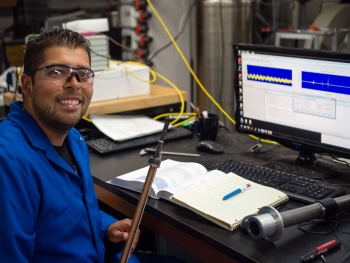
School:
Grade Level:
Teaching Position:
Supervisor:
Department:
Mentor:
Research Project Year:
Research Project Title:
Research Project Description:
Understanding how protein interacts with water in protein-water coupling is essential to better understand how proteins influence and are influenced by surrounding water molecules. Protein is greatly influenced by water in aspects of protein function and structure. In this project, we are trying to see the water dynamics at seven different sites of the molecule as a function of density and water diffusivity. We are interested in knowing how the polar and nonpolar sites correlate to the dynamics of density and diffusivity. With the use of Electron Spin Echo Envelope Modulation (ESEEM), we can track water density at each peptide site. With the use of Overhauser Dynamical Nuclear Polarization, we can see the water diffusivity rate per site per temperature (40K-300K). Ultimately, we want to see if there is a correlation between the environmental temperature and the water dynamics.
Research Project Attachments:
| Attachment | Size |
|---|---|
| 18.99 MB |
Curriculum Project Year:
Curriculum Project Title:
Curriculum Project Description:
Through this project-based learning experience, students will use the process of water purification to cover science and engineering practices, crosscutting concepts, and disciplinary core ideas in my chemistry classes and integrated chemistry/physics classes. This water purification unit will also cover themes about renewable energy and electrolysis; these two themes cover several content areas in the physical science performance expectations. The water purification project will revolve around 4-step process of water coagulation, sedimentation, filtration, and disinfection. As a tangent of electrolysis, the students will also learn about the production of hydrogen gas, the concepts of clean energy, and the transfer of energy. The project will integrate many curriculum concepts taught in chemistry and physical sciences. I predict the entire project will take about 5 weeks spread-out through a semester. This is a comprehensive unit that is attached to a real-world phenomenon, is a hands-on experience, and is a feasible experience for the classroom.
My inspiration for this project came from my own research experience with RET. The objective of my research was to understand the protein-water interactions on a protein at seven different sites of the protein. Using the techniques of Electron Spin Echo Envelope Modulation (ESEEM) and Overhauser Dynamical Nuclear Polarization (ODNP) we were able to study the water density and water diffusivity at each site of the protein. Even though the techniques used in the lab were based heavily on nuclear magnetic resonance and electron pulse resonance, there was a lot of fundamental chemistry that was applied in the lab every day. On a daily basis, I would apply concepts like: intermolecular forces, concentrations, dilutions, atomic structure, thermodynamics, bonds, chromatography, and nuclear spin. All of these concepts are learned in a regular chemistry class and were an integral part of my research experience. For that reason, I wanted to create a project that encompassed many concepts learned in chemistry all integrated in a wholesome project that connects all of these concepts well.
